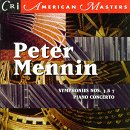| All Artists: Dimitri Mitropoulos, Igor Buketoff, Jean Martinon, John Ogdon Title: Mennin: Symphony No.3/Piano Concerto/Symphony No.7 Members Wishing: 0 Total Copies: 0 Label: Composers Recordings Release Date: 3/18/1997 Genre: Classical Styles: Forms & Genres, Concertos, Historical Periods, Modern, 20th, & 21st Century, Instruments, Keyboard, Symphonies Number of Discs: 1 SwapaCD Credits: 1 UPC: 090438074124 |
Search - Dimitri Mitropoulos, Igor Buketoff, Jean Martinon :: Mennin: Symphony No.3/Piano Concerto/Symphony No.7
 | Dimitri Mitropoulos, Igor Buketoff, Jean Martinon Mennin: Symphony No.3/Piano Concerto/Symphony No.7 Genre: Classical
|
Larger Image |
CD Details |
CD ReviewsTHE 7TH!!! The darkest & best work ever by an american! Tobias | United States | 05/22/2002 (5 out of 5 stars) "'Who the hell is Peter Mennin"? you ask.I'll tell you.In addition to to his administrative job as the dean of the julliard school of music in nyc(a post he held from the early 60's,to his untimely death at age 61,in 1983),he is also the author of the most powerfull,brutally violent,dramatic and lyrically despairing symphony ever written by an american composer.although many would give that distinction to the Ives 4th,Copland 3rd,or one of the Sessions symphonies(all great),i do not.The seventh(the variation)symphony;as it is titled,is overwhelming in it's power and craft.written in 1962-63 when Mennin was but 40(and with all the angst of the then recent Kennedy assassination),it's one movement(18 minute or so)design is flawless and faultless.the opening theme(announced forbodingly by the low strings)is the heart of the work and sets the tone of the entire piece.this (12 tone)theme is then subjected to all manner of thematic transformations,and variations,in which new motives and themes emerge,all derived from the opening one.Make no mistake, this is not a serial work.Only the main theme is.It is dissonant, but tonal-that is to say with growing familiarity,one can "hum"it(and i assure you i can,and it's great fun).Contrasting "calm and storm"episodes establish the flow of the work creating the feel of a three or four part symphony in a taut single movement.what Mennin does with rhythm(and it's variation ),is incredible.along with his genius at counterpoint and instrmentation,it is Mennins driving and very american(frenzied almost 'swinging' march tempos in duple time)rhythmic designs that give his music so much power.The sections of the orchestra fighting each other for supremacy. racing flute and woodwind flourishes (in insane registers) interupted violently by plummeting string passages,which are in turn taken over by the most hair raising brass swells you've ever heard in your life.not since Mahler has a composer used horns and bones to such effect.all these above evaluations seem to be primarily concerned with technique and craft,but the listening result is (i assure you) a totally emotional and musical one.A sound unlike any before it or since. granted this listening experience is a challenge.it took many listenings for me to understand and fall in love with this work,but it is now my favorite symphony of the 20th century,and any thing i can do to propegate it's existence,however small, is worth the effort to write this review-for this work should be known better,and performed more often. this is one of two recordings available on cd,and by far the best.the other was done recently by gerard schwartz with the seattle symph;a good second cd once you know the work from this cd.the other works on this collection are the piano concerto(the 2nd mvt is a masterstroke),and the 3rd(he wrote 9!!!sound familar)symphony.Mennin is an american master." Superb music wonderfully performed lgeorge@internetopia.net.au | Melbourne, Australia | 09/01/2001 (5 out of 5 stars) "I first heard of Peter Mennin when the Martinon performance on this CD of the seventh symphony was broadcast over the radio in Australia about 10 years ago. At the time I taped it and played it to death. I searched for many years to get the LP, without any luck, and finally found it on CD here at Amazon.com. This is a fabulous performance of an underrated and underperformed work by a top class orchestra. What more can one say? Except that the piano concerto is in a similar class, with John Ogden at his best, and there would be no better advocate for the third symphony than Mitropoulos and the NYPO. Mennin's compositions have never, to my knowledge, been performed in Australia, and one never sees more than passing references to it in English journals. I feel sure he was killed off by the American music critics of his day, with their often pejorative references to Mennin's conservative taste in clothes and other non musical trivia. His music is strongly contrapuntal, well orchestrated, and full of melodic invention. His harmonic style is firmly 20th century, with plenty of dissonance within well crafted musical structures. This CD is a good place to start with Mennin's music. My next choice would be to seek out the cello concerto performed by Janos Starker available on Albany Troy 044 (1998). Don't expect Mennin to turn up in the American Masters (Naxos) series - no plans there, so Naxos tell me." How did this get by me? Mark McCue | Denver, CO USA | 07/25/2000 (5 out of 5 stars) "Friends of mine and I have been bellyaching about this material not getting reissued. Well, it did get reissued while we were looking for it all on parent labels. These nonpareil presentations of three of Mennin's masterworks have been praised to the skies again and again, so my pipsqueaking isn't worth listening to. But the disk is, and I'm relieved that when my LPs go, I can fall back on this CD waiting in the wings in my collection. It doesn't concede very much to the LPs in sound and it perpetuates the memory of a compelling composer that we lost way too early.Add Hanson's Mercury reading of the 5th Symphony to these and you truly have a treasure chest for yourself on just two disks."
|

 Track Listings (11) - Disc #1
Track Listings (11) - Disc #1